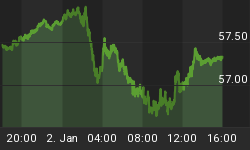Both the shape of the yield curve and the behavior of the S&P 500 stock index are components of the Conference Board's index of Leading Economic Indicators. In the third quarter, these two indicators sent divergent signals. The S&P 500 increased at an annualized rate of 15.2%; the spread between the yield on the Treasury 10-year security and the fed funds rate narrowed by 46 basis points to 0.75%. The behavior of the S&P 500 signals stronger economic growth ahead; the behavior of the yield spread signals weaker economic growth ahead. On which one does history suggest we should "place our money?" The two charts below say put your money on the yield spread's prediction.
What I have done is find the highest correlation between the quarter-to-quarter percent change in real GDP and lagged values of the percent change in the S&P 500 and lagged values of the level of the yield spread. As the charts show, the two-quarter lag of the yield spread has a correlation of 0.40 with real GDP growth, beating out the one-quarter lag of the S&P 500 by 4 basis points.
Chart 1
Chart 2
Now, a higher correlation by only 4 basis points is not a lot to hang your hat on. But notice that the yield spread leads real GDP growth by two quarters whereas the change in the S&P 500 leads by only one quarter. This suggests that the yield spread might even be a bit of a predictor of the behavior of the S&P 500. Moreover, as Charts 3 and 4 show, the S&P 500 gives more false "recession" signals than does the yield spread. (The shaded regions in Charts 3 and 4 denote recessions in the US.) Lastly, Fed Chairman Greenspan disparages the usefulness of the yield spread as a leading indicator. I have found Greenspan to be a pretty reliable contra-indicator throughout his professional career.
Chart 3
Chart 4
















